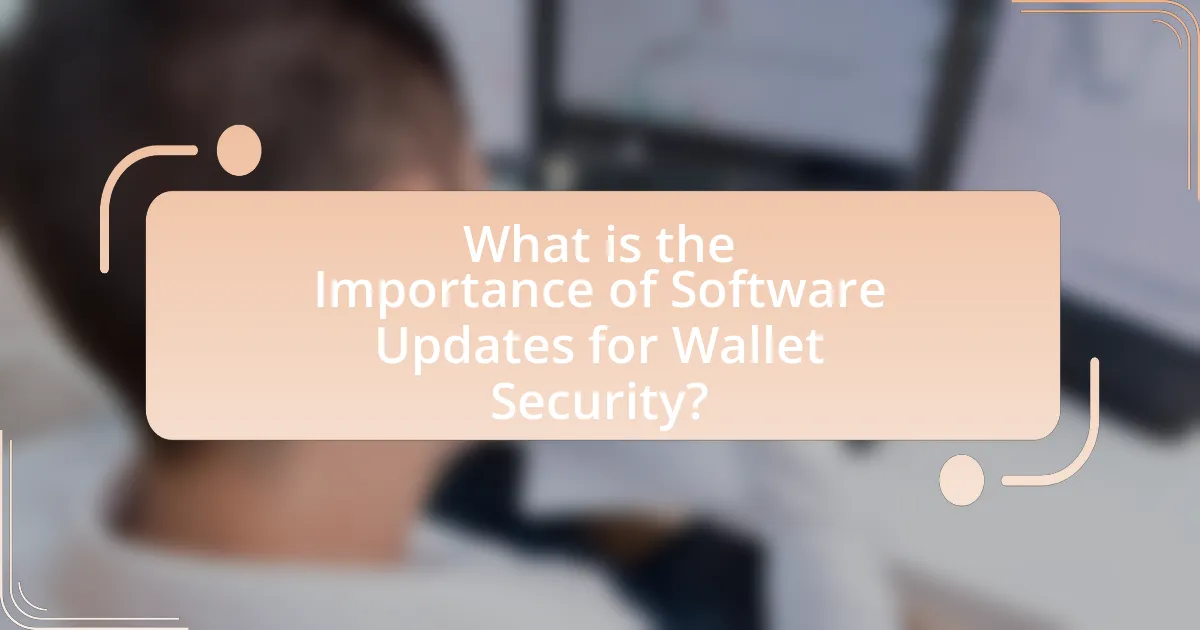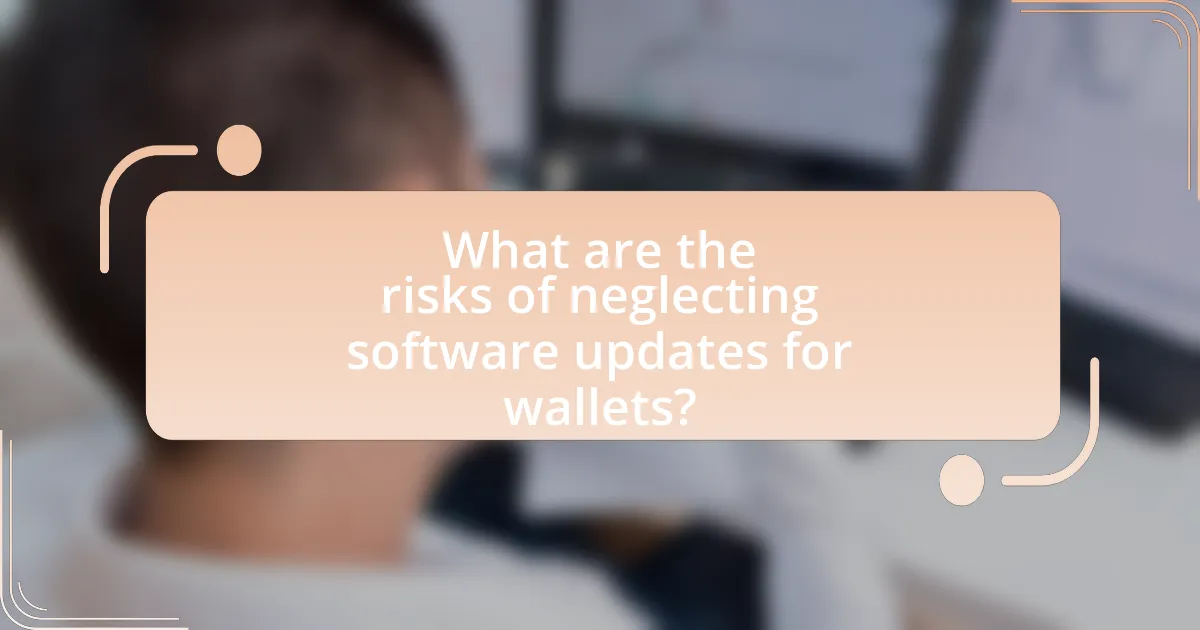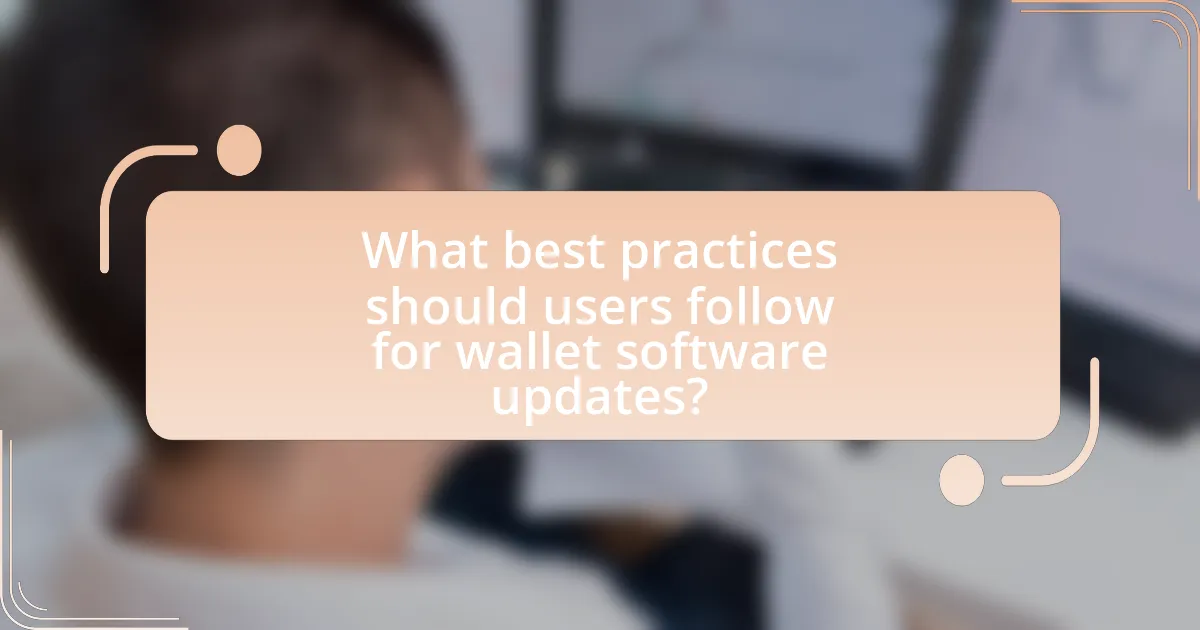Software updates play a critical role in ensuring wallet security by addressing vulnerabilities and enhancing protection against emerging cyber threats. Regular updates are essential for patching security flaws that could be exploited by cybercriminals, with studies indicating that a significant percentage of data breaches are linked to unpatched vulnerabilities. The article discusses the importance of keeping wallet software up to date, the risks associated with outdated wallets, and the key components of wallet security, including encryption and two-factor authentication. It also outlines best practices for users to follow regarding software updates, emphasizing the need for timely updates to safeguard sensitive financial information and maintain user trust.

What is the Importance of Software Updates for Wallet Security?
Software updates are crucial for wallet security as they address vulnerabilities and enhance protection against emerging threats. Regular updates patch security flaws that could be exploited by cybercriminals, thereby safeguarding sensitive financial information. For instance, a report by the Cybersecurity & Infrastructure Security Agency (CISA) indicates that 60% of data breaches are linked to unpatched vulnerabilities. Therefore, keeping wallet software up to date is essential for maintaining robust security and preventing unauthorized access.
Why are software updates crucial for wallet security?
Software updates are crucial for wallet security because they address vulnerabilities and enhance protection against emerging threats. Regular updates patch security flaws that could be exploited by cybercriminals, thereby reducing the risk of unauthorized access to sensitive financial information. For instance, a report by the Cybersecurity and Infrastructure Security Agency (CISA) highlights that 60% of data breaches occur due to unpatched vulnerabilities. Therefore, keeping wallet software up to date is essential for maintaining robust security and safeguarding digital assets.
What vulnerabilities do outdated wallets face?
Outdated wallets face significant vulnerabilities, primarily due to unpatched security flaws and lack of support for new cryptographic standards. These vulnerabilities can lead to unauthorized access, loss of funds, and exposure to malware attacks. For instance, a study by the European Union Agency for Cybersecurity (ENISA) highlighted that outdated software often contains known exploits that attackers can easily leverage, resulting in increased risks for users. Additionally, as new security protocols are developed, outdated wallets may not be compatible, leaving them susceptible to emerging threats.
How do updates protect against emerging threats?
Updates protect against emerging threats by providing essential security patches and enhancements that address newly discovered vulnerabilities. Software developers continuously monitor for potential security risks and, upon identifying these threats, release updates to mitigate them. For instance, in 2020, the Cybersecurity and Infrastructure Security Agency (CISA) reported that timely updates could prevent exploitation of vulnerabilities, as seen in the case of the Microsoft Exchange Server vulnerabilities that were actively exploited before patches were released. By regularly applying updates, users can significantly reduce their risk of falling victim to cyberattacks that exploit these vulnerabilities.
What are the key components of wallet security?
The key components of wallet security include strong encryption, two-factor authentication, secure backup, and regular software updates. Strong encryption protects sensitive data by converting it into a format that is unreadable without the correct decryption key. Two-factor authentication adds an extra layer of security by requiring a second form of verification, such as a code sent to a mobile device. Secure backup ensures that wallet data can be restored in case of loss or theft, while regular software updates address vulnerabilities and enhance security features, reducing the risk of exploitation. These components collectively safeguard against unauthorized access and data breaches.
How does encryption play a role in wallet security?
Encryption is crucial for wallet security as it protects sensitive information, such as private keys and transaction data, from unauthorized access. By converting this data into a coded format, encryption ensures that only authorized users with the correct decryption key can access the information. For instance, wallets that utilize strong encryption algorithms, like AES (Advanced Encryption Standard), significantly reduce the risk of data breaches and theft. According to a study by the National Institute of Standards and Technology, encryption can prevent unauthorized access to sensitive data, thereby enhancing overall security measures in digital wallets.
What is the significance of two-factor authentication in wallets?
Two-factor authentication (2FA) significantly enhances the security of wallets by requiring two forms of verification before granting access. This additional layer of security mitigates the risk of unauthorized access, as even if a password is compromised, the second factor—often a temporary code sent to a mobile device—remains secure. According to a study by Google, implementing 2FA can block 99.9% of automated attacks, demonstrating its effectiveness in protecting sensitive financial information stored in wallets.
How do software updates enhance user trust in wallets?
Software updates enhance user trust in wallets by addressing security vulnerabilities and improving functionality. Regular updates demonstrate a commitment to user safety, as they often include patches for identified security flaws that could be exploited by malicious actors. For instance, a study by the Ponemon Institute found that 60% of data breaches are linked to unpatched vulnerabilities, highlighting the importance of timely updates in maintaining wallet security. Additionally, updates can introduce new features that enhance user experience, further solidifying trust in the wallet’s reliability and performance.
What impact do updates have on user experience?
Updates significantly enhance user experience by improving functionality, security, and performance. For instance, software updates often fix bugs that can hinder usability, leading to a smoother interaction with the application. Additionally, updates frequently include security patches that protect user data from vulnerabilities, thereby increasing user trust and satisfaction. According to a study by the Ponemon Institute, 60% of users reported feeling more secure after applying software updates, which directly correlates to a positive user experience. Furthermore, updates can introduce new features that enhance usability, making the software more engaging and efficient for users.
How do regular updates influence user retention?
Regular updates significantly enhance user retention by improving software performance and security. When users receive consistent updates, they experience fewer bugs and vulnerabilities, which fosters trust and satisfaction. According to a study by App Annie, apps that receive regular updates see a 20% increase in user engagement, as users are more likely to continue using applications that evolve and address their needs. This consistent improvement not only keeps the software relevant but also reassures users that their data is secure, further solidifying their loyalty to the application.

What are the risks of neglecting software updates for wallets?
Neglecting software updates for wallets significantly increases the risk of security vulnerabilities. Outdated wallet software may contain unpatched bugs or flaws that cybercriminals can exploit, leading to unauthorized access and potential loss of funds. For instance, the 2019 hack of the Binance exchange, which resulted in the theft of 7,000 Bitcoin, was partly attributed to outdated security measures. Additionally, failure to update can expose wallets to malware and phishing attacks, as attackers often target known vulnerabilities in older software versions. Regular updates are essential to ensure that wallets have the latest security features and protections against emerging threats.
What potential threats arise from outdated wallet software?
Outdated wallet software poses significant threats, including increased vulnerability to cyberattacks and exploitation of known security flaws. When wallet software is not regularly updated, it lacks the latest security patches that protect against malware, phishing attacks, and unauthorized access. For instance, a study by the Cybersecurity & Infrastructure Security Agency (CISA) highlighted that 60% of breaches exploit known vulnerabilities for which patches are available. Additionally, outdated software may not support new security protocols, leaving users exposed to risks such as data theft and loss of funds.
How can malware exploit outdated wallet applications?
Malware can exploit outdated wallet applications by taking advantage of unpatched vulnerabilities that exist in older software versions. These vulnerabilities may include security flaws that allow unauthorized access to sensitive information, such as private keys or user credentials. For instance, a study by the Cybersecurity and Infrastructure Security Agency (CISA) highlighted that outdated software often lacks the latest security enhancements, making it easier for malware to infiltrate and manipulate the application. Additionally, malware can utilize techniques like phishing or man-in-the-middle attacks to intercept data transmitted through these outdated wallets, further compromising user security.
What are the consequences of data breaches in wallets?
Data breaches in wallets can lead to significant financial losses and identity theft for users. When a wallet’s security is compromised, attackers can access sensitive information such as private keys and personal data, enabling them to steal funds or impersonate the wallet owner. According to a report by Cybersecurity Ventures, global cybercrime damages are projected to reach $10.5 trillion annually by 2025, highlighting the severe impact of data breaches. Additionally, the loss of user trust can result in decreased adoption of digital wallets, affecting the overall market.
How does the frequency of updates affect wallet security?
The frequency of updates significantly enhances wallet security by addressing vulnerabilities and implementing the latest security protocols. Regular updates ensure that any identified security flaws are patched promptly, reducing the risk of exploitation by malicious actors. For instance, a study by the Ponemon Institute found that organizations that frequently update their software experience 50% fewer security breaches compared to those that do not prioritize updates. This demonstrates that consistent software maintenance is crucial for safeguarding digital wallets against emerging threats.
What is the recommended update schedule for wallet software?
The recommended update schedule for wallet software is to check for updates at least once a month. Regular updates are crucial for maintaining security, as they often include patches for vulnerabilities that could be exploited by attackers. According to cybersecurity best practices, software should be updated promptly when new versions are released, especially if they address security issues. This proactive approach helps ensure that users are protected against emerging threats and vulnerabilities.
How do rapid updates address urgent security flaws?
Rapid updates address urgent security flaws by quickly deploying patches that fix vulnerabilities before they can be exploited. This proactive approach minimizes the window of opportunity for attackers, thereby reducing the risk of data breaches and financial loss. For instance, in 2020, the Cybersecurity and Infrastructure Security Agency (CISA) reported that timely updates could prevent up to 85% of known vulnerabilities from being exploited. By ensuring that software remains current, organizations can effectively safeguard sensitive information and maintain user trust.

What best practices should users follow for wallet software updates?
Users should regularly update their wallet software to ensure optimal security and functionality. Regular updates often include critical security patches that protect against vulnerabilities, as evidenced by the fact that 60% of cyberattacks exploit known vulnerabilities for which patches exist. Users should enable automatic updates when available, as this ensures they receive the latest security enhancements without manual intervention. Additionally, users should verify the authenticity of updates by downloading them directly from the official website or trusted sources, reducing the risk of malware. Finally, users should back up their wallet data before performing updates to prevent data loss, as updates can occasionally lead to unexpected issues.
How can users ensure they are receiving the latest updates?
Users can ensure they are receiving the latest updates by enabling automatic updates on their devices and regularly checking for updates manually. Automatic updates allow software to install the latest security patches and features as soon as they are released, minimizing the risk of vulnerabilities. Additionally, users should visit the official website of the software provider to verify the latest version and download updates directly if necessary. According to a report by the Cybersecurity & Infrastructure Security Agency, timely software updates are critical in protecting against known security threats, emphasizing the importance of staying current with updates for wallet security.
What steps should users take to enable automatic updates?
To enable automatic updates, users should access their device’s settings and locate the update section. In most operating systems, this can be found under “System” or “Software Update.” Users must then toggle the option for automatic updates to the “On” position. This ensures that the device will regularly check for and install updates without manual intervention. For example, on Windows, users can go to Settings > Update & Security > Windows Update and select “Change active hours” to ensure updates occur at convenient times. Enabling automatic updates is crucial for maintaining wallet security, as it ensures that the latest security patches and features are applied promptly, reducing vulnerability to threats.
How can users verify the authenticity of updates?
Users can verify the authenticity of updates by checking the digital signatures and hashes provided by the software developers. Digital signatures ensure that the update comes from a legitimate source, while hashes allow users to confirm that the update has not been altered during transmission. For instance, reputable software providers often publish their public keys and hash values on their official websites, enabling users to cross-reference these with the downloaded files. This method is widely recognized in cybersecurity practices, as it helps prevent the installation of malicious software disguised as legitimate updates.
What common troubleshooting tips exist for wallet update issues?
Common troubleshooting tips for wallet update issues include ensuring a stable internet connection, verifying that the wallet software is compatible with the device’s operating system, and checking for sufficient storage space on the device. Additionally, users should restart the wallet application or the device itself, as this can resolve temporary glitches. If the update fails, users should consult the wallet’s official support documentation or community forums for specific guidance related to their wallet type. These steps are effective as they address the most frequent causes of update failures, such as connectivity problems and software incompatibilities.
How can users resolve failed update installations?
Users can resolve failed update installations by first checking their internet connection to ensure it is stable and active. If the connection is fine, they should restart their device, as this can clear temporary issues that may be causing the failure. Next, users should check for sufficient storage space, as insufficient space can prevent updates from installing. If these steps do not resolve the issue, users can manually download the update from the official website of the software provider, ensuring they are using the correct version for their system. Additionally, running the update troubleshooter, available in many operating systems, can help identify and fix problems related to updates. These methods are effective as they address common causes of update failures, such as connectivity issues, storage limitations, and software conflicts.
What should users do if their wallet becomes unresponsive after an update?
If a user’s wallet becomes unresponsive after an update, they should first attempt to restart the wallet application. Restarting the application can resolve temporary glitches that may have occurred during the update process. If the issue persists, users should check for any additional updates or patches that may address the unresponsiveness, as developers often release fixes shortly after major updates. Additionally, users can consult the wallet’s official support resources or community forums for troubleshooting steps specific to their wallet type. These actions are based on common practices in software maintenance, where restarting applications and applying subsequent updates are standard procedures for resolving software issues.